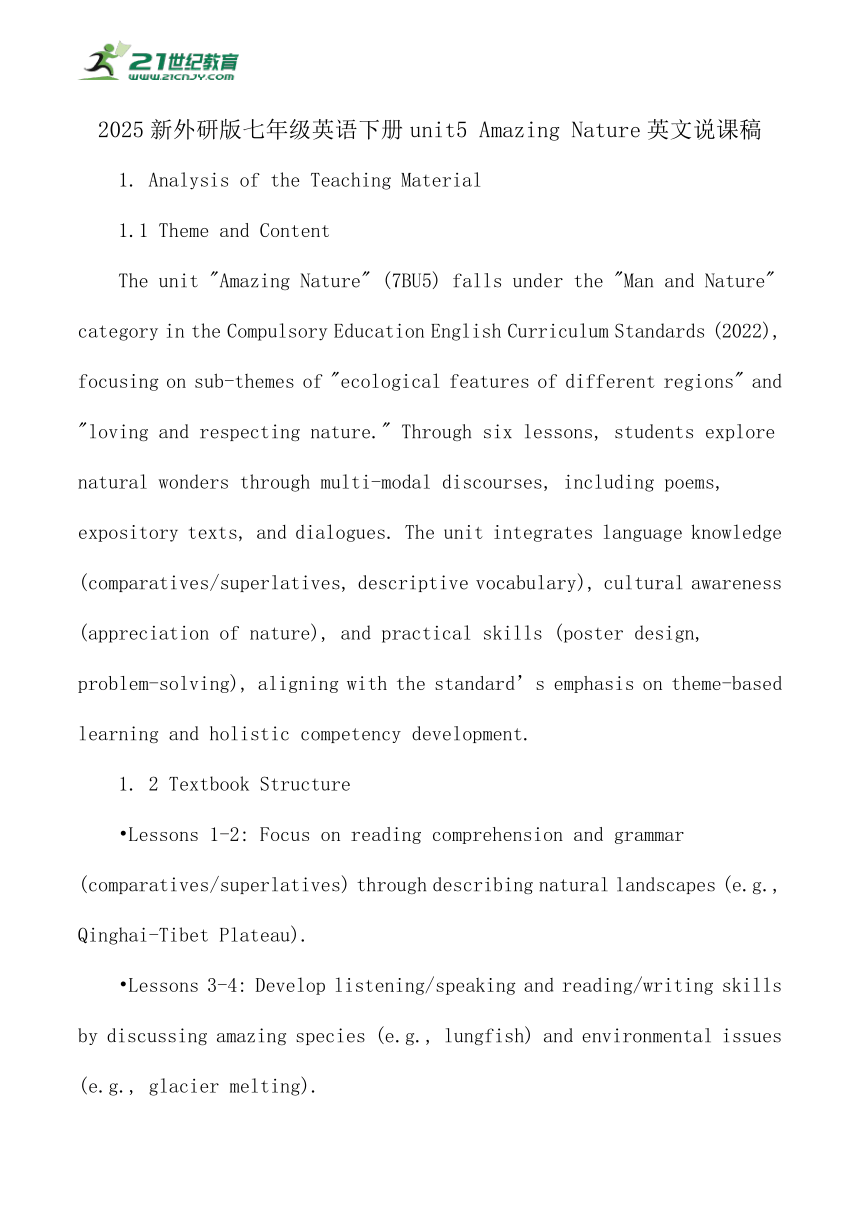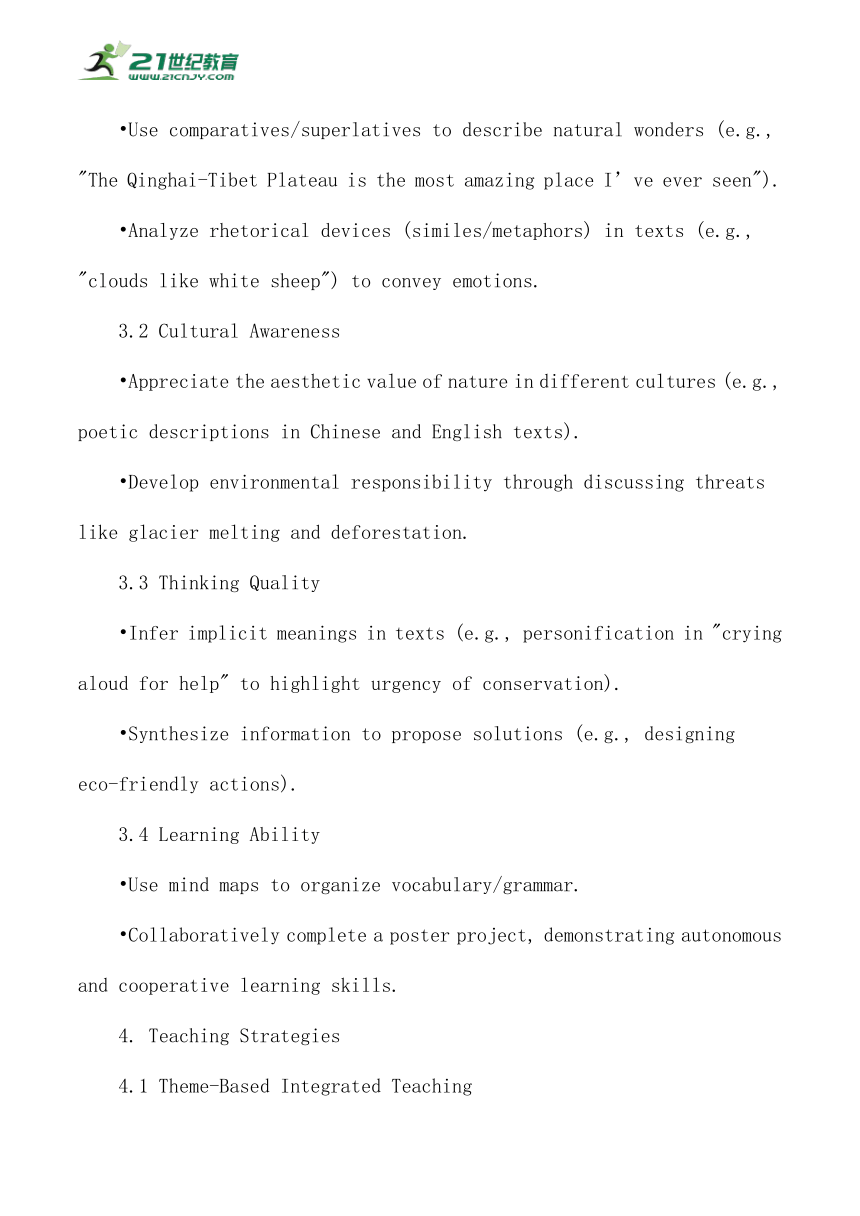unit5 Amazing Nature英文说课稿 2025新外研版七年级英语下册
文档属性
| 名称 | unit5 Amazing Nature英文说课稿 2025新外研版七年级英语下册 |  | |
| 格式 | docx | ||
| 文件大小 | 37.8KB | ||
| 资源类型 | 试卷 | ||
| 版本资源 | 外研版 | ||
| 科目 | 英语 | ||
| 更新时间 | 2025-05-27 06:34:43 | ||
图片预览



文档简介
2025新外研版七年级英语下册unit5 Amazing Nature英文说课稿
1. Analysis of the Teaching Material
1.1 Theme and Content
The unit "Amazing Nature" (7BU5) falls under the "Man and Nature" category in the Compulsory Education English Curriculum Standards (2022), focusing on sub-themes of "ecological features of different regions" and "loving and respecting nature." Through six lessons, students explore natural wonders through multi-modal discourses, including poems, expository texts, and dialogues. The unit integrates language knowledge (comparatives/superlatives, descriptive vocabulary), cultural awareness (appreciation of nature), and practical skills (poster design, problem-solving), aligning with the standard’s emphasis on theme-based learning and holistic competency development.
1. 2 Textbook Structure
Lessons 1-2: Focus on reading comprehension and grammar (comparatives/superlatives) through describing natural landscapes (e.g., Qinghai-Tibet Plateau).
Lessons 3-4: Develop listening/speaking and reading/writing skills by discussing amazing species (e.g., lungfish) and environmental issues (e.g., glacier melting).
Lessons 5-6: Culminate in a project where students design posters to advocate for nature protection, applying language in real-world contexts.
This structure follows the curriculum’s "learning-understanding → application-practice → migration-innovation" activity sequence, promoting deep learning.
2. Analysis of Learners
Language Proficiency: Seventh-grade students have mastered basic adjectives and simple sentences but need scaffolding for complex grammar (e.g., superlatives) and abstract concepts (e.g., ecological threats).
Cognitive Features: They thrive on visual and interactive activities but require guidance to transition from concrete descriptions to critical thinking (e.g., analyzing environmental problems).
Emotional Needs: Curious about nature, they can be motivated through real-world connections (e.g., local ecological issues) and collaborative projects, aligning with the standard’s focus on student-centered, context-driven learning.
3. Teaching Objectives (Aligned with Core Competencies)
3.1 Language Competence
Use comparatives/superlatives to describe natural wonders (e.g., "The Qinghai-Tibet Plateau is the most amazing place I’ve ever seen").
Analyze rhetorical devices (similes/metaphors) in texts (e.g., "clouds like white sheep") to convey emotions.
3.2 Cultural Awareness
Appreciate the aesthetic value of nature in different cultures (e.g., poetic descriptions in Chinese and English texts).
Develop environmental responsibility through discussing threats like glacier melting and deforestation.
3.3 Thinking Quality
Infer implicit meanings in texts (e.g., personification in "crying aloud for help" to highlight urgency of conservation).
Synthesize information to propose solutions (e.g., designing eco-friendly actions).
3.4 Learning Ability
Use mind maps to organize vocabulary/grammar.
Collaboratively complete a poster project, demonstrating autonomous and cooperative learning skills.
4. Teaching Strategies
4.1 Theme-Based Integrated Teaching
Contextualization: Use visuals (e.g., Tibet Plateau images) and real data (e.g., glacier reduction statistics) to anchor language in authentic scenarios.
Cross-disciplinary Links: Integrate geography (ecological regions) and biology (unique species) to deepen thematic understanding.
4.2 English Learning Activity View
Learning-Understanding: Predict text content via pictures; summarize key details (e.g., in Lesson 1’s "Colours of My Hometown").
Application-Practice: Role-play dialogues about museum visits (Lesson 3) and write paragraphs on endangered wonders (Lesson 5).
Migration-Innovation: Design a "Save Our Wonders" poster with persuasive language, integrating research and creativity.
4.3 Technology Integration
Use AI-assisted tools (e.g., pronunciation apps) for listening/speaking practice.
Utilize digital platforms for peer feedback on posters, aligning with the standard’s emphasis on IT-enhanced learning.
5. Teaching Procedures (Highlighting Key Lessons)
5.1 Lesson 1: Text Analysis ("Colours of My Hometown")
Lead-in: Show Qinghai-Tibet Plateau images; ask: What colours do you see How do they make you feel (激活 prior knowledge).
Reading:
oSkim for main idea: Identify the writer’s favorite colours and their symbolic meanings.
oClose read: Analyze similes (e.g., "mountains like white lotus") and discuss how language expresses love for nature.
Output: Describe hometown colours using comparatives, fostering patriotic feelings.
5.3 Lesson 4: Reading for Writing ("Crying Aloud for Help")
Pre-reading: Predict themes from titles/photos (e.g., Dead Sea’s crisis).
While-reading:
oIdentify problems (e.g., water level drop, deforestation) and solutions using a cause-effect chart.
oAnalyze personification: "I’m disappearing" to evoke empathy.
Post-reading:Debate: "Can technology save natural wonders " Promote critical thinking.
5.6 Project-Based Learning (Poster Design)
Task: Groups design posters for a "Natural Wonders Protection Campaign," including:
oDescription (language: comparatives, descriptive verbs).
oThreats (e.g., climate change) and solutions (e.g., reforestation).
Presentation: Use rubrics to evaluate clarity, creativity, and ecological awareness, aligning with "teaching-assessment integration."
6. Assessment Design
6.1 Formative Assessment
Classroom Observation: Monitor participation in discussions and peer feedback.
Learning Portfolios: Collect drafts, mind maps, and self-reflection logs to track progress.
6.2 Summative Assessment
Poster Rubric: Evaluate language accuracy (40%), thematic depth (30%), and collaborative skills (30%).
Written Reflection: "What can I do for nature " to assess values alignment with curriculum goals.
7. Design Philosophy (Curriculum Standards Integration)
1.Core Competency Orientation: All activities target holistic development of language, culture, thinking, and learning abilities.
2.Theme-Driven Inquiry: Centering "nature protection" fosters both language use and ecological literacy.
3.Activity-Based Learning: Sequenced tasks (from reading to project) ensure gradual skill progression.
4.Assessment for Learning: Rubrics and self-reflection embed evaluation into learning, promoting metacognition.
This design embodies the standards’ vision of "cultivating responsible global citizens through language learning," combining linguistic proficiency with humanistic care.
Conclusion:
This teaching plan presentation script demonstrates a standards-aligned, student-centered approach, where language learning is contextualized, inquiry-driven, and ethically meaningful. By integrating nature appreciation with critical thinking, it prepares students to become articulate advocates for the planet, embodying the essence of the Compulsory Education English Curriculum.
Thank you!
1. Analysis of the Teaching Material
1.1 Theme and Content
The unit "Amazing Nature" (7BU5) falls under the "Man and Nature" category in the Compulsory Education English Curriculum Standards (2022), focusing on sub-themes of "ecological features of different regions" and "loving and respecting nature." Through six lessons, students explore natural wonders through multi-modal discourses, including poems, expository texts, and dialogues. The unit integrates language knowledge (comparatives/superlatives, descriptive vocabulary), cultural awareness (appreciation of nature), and practical skills (poster design, problem-solving), aligning with the standard’s emphasis on theme-based learning and holistic competency development.
1. 2 Textbook Structure
Lessons 1-2: Focus on reading comprehension and grammar (comparatives/superlatives) through describing natural landscapes (e.g., Qinghai-Tibet Plateau).
Lessons 3-4: Develop listening/speaking and reading/writing skills by discussing amazing species (e.g., lungfish) and environmental issues (e.g., glacier melting).
Lessons 5-6: Culminate in a project where students design posters to advocate for nature protection, applying language in real-world contexts.
This structure follows the curriculum’s "learning-understanding → application-practice → migration-innovation" activity sequence, promoting deep learning.
2. Analysis of Learners
Language Proficiency: Seventh-grade students have mastered basic adjectives and simple sentences but need scaffolding for complex grammar (e.g., superlatives) and abstract concepts (e.g., ecological threats).
Cognitive Features: They thrive on visual and interactive activities but require guidance to transition from concrete descriptions to critical thinking (e.g., analyzing environmental problems).
Emotional Needs: Curious about nature, they can be motivated through real-world connections (e.g., local ecological issues) and collaborative projects, aligning with the standard’s focus on student-centered, context-driven learning.
3. Teaching Objectives (Aligned with Core Competencies)
3.1 Language Competence
Use comparatives/superlatives to describe natural wonders (e.g., "The Qinghai-Tibet Plateau is the most amazing place I’ve ever seen").
Analyze rhetorical devices (similes/metaphors) in texts (e.g., "clouds like white sheep") to convey emotions.
3.2 Cultural Awareness
Appreciate the aesthetic value of nature in different cultures (e.g., poetic descriptions in Chinese and English texts).
Develop environmental responsibility through discussing threats like glacier melting and deforestation.
3.3 Thinking Quality
Infer implicit meanings in texts (e.g., personification in "crying aloud for help" to highlight urgency of conservation).
Synthesize information to propose solutions (e.g., designing eco-friendly actions).
3.4 Learning Ability
Use mind maps to organize vocabulary/grammar.
Collaboratively complete a poster project, demonstrating autonomous and cooperative learning skills.
4. Teaching Strategies
4.1 Theme-Based Integrated Teaching
Contextualization: Use visuals (e.g., Tibet Plateau images) and real data (e.g., glacier reduction statistics) to anchor language in authentic scenarios.
Cross-disciplinary Links: Integrate geography (ecological regions) and biology (unique species) to deepen thematic understanding.
4.2 English Learning Activity View
Learning-Understanding: Predict text content via pictures; summarize key details (e.g., in Lesson 1’s "Colours of My Hometown").
Application-Practice: Role-play dialogues about museum visits (Lesson 3) and write paragraphs on endangered wonders (Lesson 5).
Migration-Innovation: Design a "Save Our Wonders" poster with persuasive language, integrating research and creativity.
4.3 Technology Integration
Use AI-assisted tools (e.g., pronunciation apps) for listening/speaking practice.
Utilize digital platforms for peer feedback on posters, aligning with the standard’s emphasis on IT-enhanced learning.
5. Teaching Procedures (Highlighting Key Lessons)
5.1 Lesson 1: Text Analysis ("Colours of My Hometown")
Lead-in: Show Qinghai-Tibet Plateau images; ask: What colours do you see How do they make you feel (激活 prior knowledge).
Reading:
oSkim for main idea: Identify the writer’s favorite colours and their symbolic meanings.
oClose read: Analyze similes (e.g., "mountains like white lotus") and discuss how language expresses love for nature.
Output: Describe hometown colours using comparatives, fostering patriotic feelings.
5.3 Lesson 4: Reading for Writing ("Crying Aloud for Help")
Pre-reading: Predict themes from titles/photos (e.g., Dead Sea’s crisis).
While-reading:
oIdentify problems (e.g., water level drop, deforestation) and solutions using a cause-effect chart.
oAnalyze personification: "I’m disappearing" to evoke empathy.
Post-reading:Debate: "Can technology save natural wonders " Promote critical thinking.
5.6 Project-Based Learning (Poster Design)
Task: Groups design posters for a "Natural Wonders Protection Campaign," including:
oDescription (language: comparatives, descriptive verbs).
oThreats (e.g., climate change) and solutions (e.g., reforestation).
Presentation: Use rubrics to evaluate clarity, creativity, and ecological awareness, aligning with "teaching-assessment integration."
6. Assessment Design
6.1 Formative Assessment
Classroom Observation: Monitor participation in discussions and peer feedback.
Learning Portfolios: Collect drafts, mind maps, and self-reflection logs to track progress.
6.2 Summative Assessment
Poster Rubric: Evaluate language accuracy (40%), thematic depth (30%), and collaborative skills (30%).
Written Reflection: "What can I do for nature " to assess values alignment with curriculum goals.
7. Design Philosophy (Curriculum Standards Integration)
1.Core Competency Orientation: All activities target holistic development of language, culture, thinking, and learning abilities.
2.Theme-Driven Inquiry: Centering "nature protection" fosters both language use and ecological literacy.
3.Activity-Based Learning: Sequenced tasks (from reading to project) ensure gradual skill progression.
4.Assessment for Learning: Rubrics and self-reflection embed evaluation into learning, promoting metacognition.
This design embodies the standards’ vision of "cultivating responsible global citizens through language learning," combining linguistic proficiency with humanistic care.
Conclusion:
This teaching plan presentation script demonstrates a standards-aligned, student-centered approach, where language learning is contextualized, inquiry-driven, and ethically meaningful. By integrating nature appreciation with critical thinking, it prepares students to become articulate advocates for the planet, embodying the essence of the Compulsory Education English Curriculum.
Thank you!
同课章节目录
